| JANUARY 2018 |
| Kabukiza (T˘ky˘) |  |
| Dates | 2 ~ 26 January 2018 Kotobuki Hatsuharu ďkabuki Congratulation Early Spring Grand Kabuki |
| MatinÚe |
Hakone Reigen Chikai no Adauchi (Izari no Adauchi) Shichi Fukujin
|
| Evening | |
| Casting |
Living National Treasure Sakata T˘jűr˘, Living National Treasure Nakamura Kichiemon, Living National Treasure Nakamura T˘z˘, Matsumoto Haku˘, Matsumoto K˘shir˘, Ichikawa Somegor˘, Nakamura Shikan, Nakamura Jakuemon, Nakamura Ganjir˘, Nakamura Senjaku, Kataoka Takatar˘, Ichikawa Sadanji, Band˘ Yajűr˘, Kataoka Hidetar˘, Ichikawa Ennosuke, Nakamura Shichinosuke, Kataoka Ainosuke, Nakamura Kankur˘, Nakamura Karoku, Nakamura Matagor˘, Ichikawa Monnosuke, Ichikawa Komaz˘ |
| Comments |
The traditional two programs for the New Year Grand Kabuki at the Kabukiza, which celebrate the first month of the 3-generation K˘raiya shűmei (K˘raiya Sandai Shűmei) of Matsumoto Haku˘ II, Matsumoto K˘shir˘ X and Ichikawa Somegor˘ VIII.
|
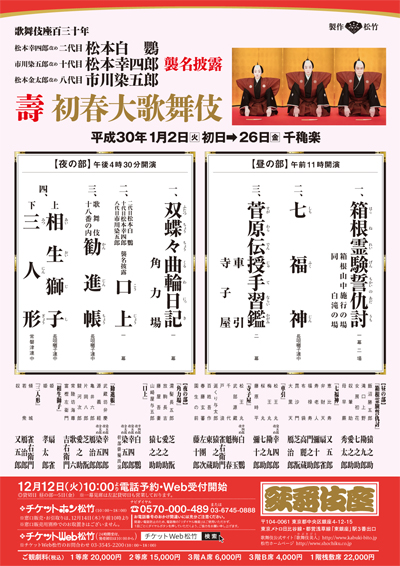 |
| Sh˘chikuza (ďsaka) |  |
| Dates | 2 ~ 26 January 2018 Band˘ Tamasabur˘ Hatsuharu Tokubetsu Buy˘ K˘en Band˘ Tamasabur˘ Early Spring Special Dance Performances |
| Program |
Aki no Irokusa Keisei |
| Casting |
Living National Treasure Band˘ Tamasabur˘, Nakamura Kazutar˘ |
| Comments |
A special Buy˘ program at the Sh˘chikuza starring Living National Treasure Band˘ Tamasabur˘.
|
| National Theatre (T˘ky˘) |
| Dates | 3 ~ 27 January 2018 |
| Program |
Sekai no Hana Oguri Hangan |
| Casting |
Living National Treasure Onoe Kikugor˘, Nakamura Tokiz˘, Onoe Kikunosuke, Onoe Sh˘roku, Ichikawa Danz˘, Band˘ Rakuzen, Kataoka Kamez˘, Band˘ Hikosabur˘, Band˘ Kamez˘, Kawarasaki Gonjűr˘, Ichimura Manjir˘, Nakamura Baishi, Nakamura Mantar˘, Onoe Ukon, Band˘ Shűch˘, Ichimura Takematsu, Ichimura Kitsutar˘ |
| Comments |
"Sekai no Hana Oguri Hangan" is a revival and a revised version of Chikamatsu Tokuz˘ and Nagawa Tokusuke I long-forgotten drama "Hime Kurabe Futaba Ez˘ji", which was premiered more than 217 years ago, in the 10th lunar month of 1800 in ďsaka at the Kado no Shibai.
|
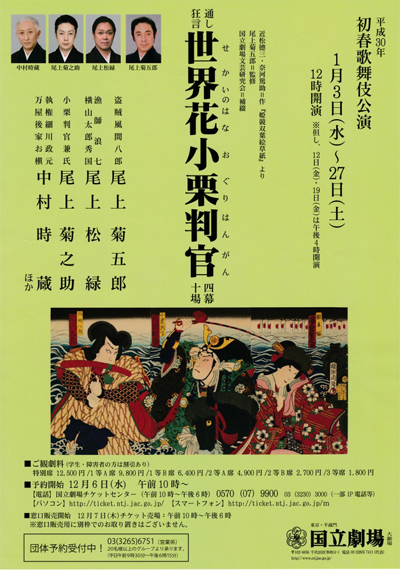 |
| Shinbashi Enbuj˘ (T˘ky˘) |  |
| Dates | 3 ~ 26 January 2018 Hatsuharu Kabuki K˘en Early Spring Kabuki Performances |
| Program A |
Kamakura Hachimangű Shizuka no H˘rakumai |
| Program B |
Nihon Mukashi Banashi |
| Casting |
Ichikawa Ebiz˘, Ichikawa Udanji, Nakamura Shid˘, ďtani Tomoemon, Kataoka Ichiz˘, Ichimura Kakitsu, Ichikawa Sai'nyű, Ichikawa Emisabur˘, Ichikawa Emiya, Nakamura Matsue, Ichikawa Kudanji, Kamimura Kichiya, Nakamura Baika, Nakamura Kotar˘, ďtani Hiromatsu, Nakamura Takanosuke, Ichikawa K˘tar˘, Horikoshi Reika |
| Comments |
The traditional New Year Kabuki at the Shinbashi Enbuj˘ with a troupe led by the young star Ichikawa Ebiz˘. His daughter makes his hatsubutai, playing the role of Princess Kaguya (as a child) in "Nihon Mukashi Banashi".
|
 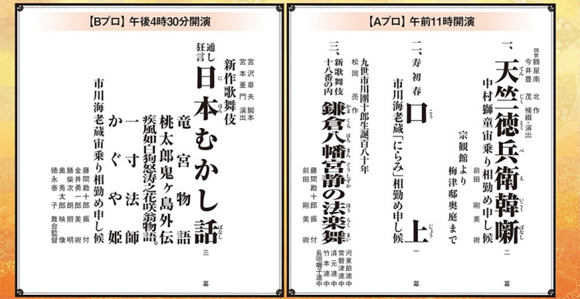 |
|
|||
| Dates | 2 ~ 26 January 2018 Shinshun Asakusa Kabuki New Year Asakusa Kabuki |
||
| MatinÚe |
Otoshidama (Nenshi Goaisatsu) |
||
| Evening |
Otoshidama (Nenshi Goaisatsu) |
||
| Casting |
Onoe Matsuya, Band˘ Minosuke, Nakamura Kash˘, Band˘ Shingo, Nakamura Yonekichi, Nakamura Hayato, Nakamura Tanenosuke, Nakamura Kamenoj˘, Nakamura Umemaru |
||
| Comments |
The yearly show for young promising actors at the Asakusa K˘kaid˘ in Asakusa, a lively and colorful neighboorhood that keeps the scent of old Edo.
|
||
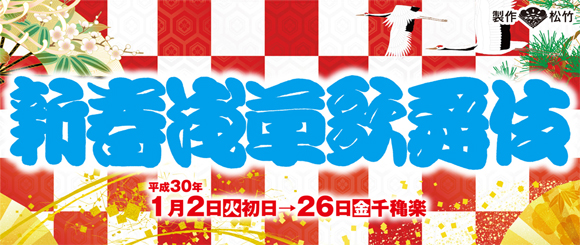 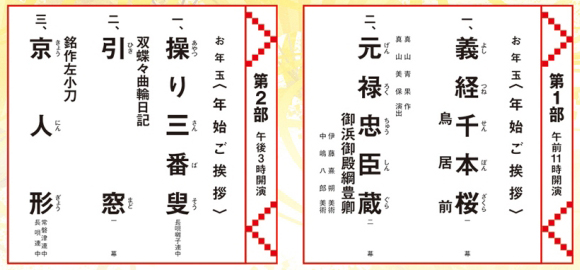 |
|
|||
| Dates | 11 ~ 23 January 2018 Zenshinza Hatsuharu Tokubetsu K˘en Zenshinza Early Spring Special Performances |
||
| Program |
Hatsusugata Ponto no Nigiwai T˘nasuya |
||
| Casting |
Fujikawa Yanosuke, Kawarasaki Kunitar˘, Yamazaki Tatsusabur˘, Yamazaki Ryűnosuke, Tadamura Shin'ya, Tamaura Yűnosuke, Anegawa Shinnosuke |
||
| Comments |
The traditional Zenshinza New Year performances in Ky˘to. As the Minamiza is closed, it is staged at the Pontoch˘ Kaburenj˘, a venue in the famous hanamachi district of Pontoch˘. |
||
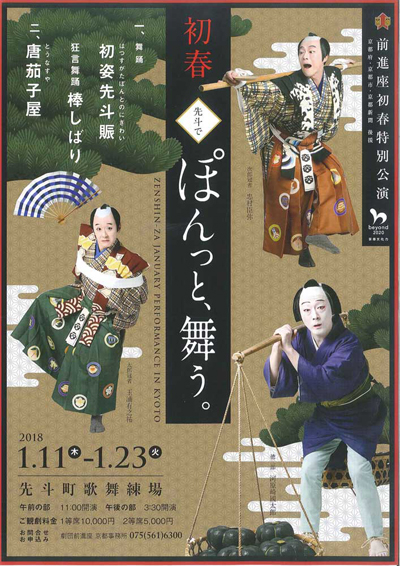 |
|
|
| Contact | Main | Top | Updates | Actors | Plays | Playwrights | Programs | Links | FAQ | Glossary | Chronology | Illustrations | Prints | Characters | Derivatives | Theaters | Coming soon | News |
